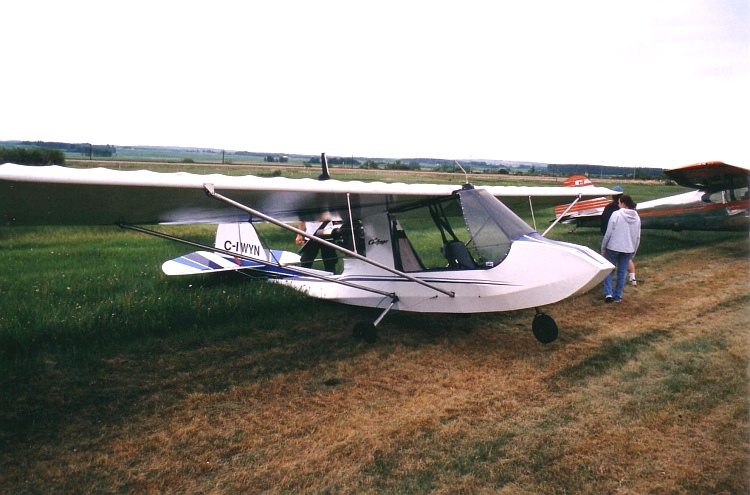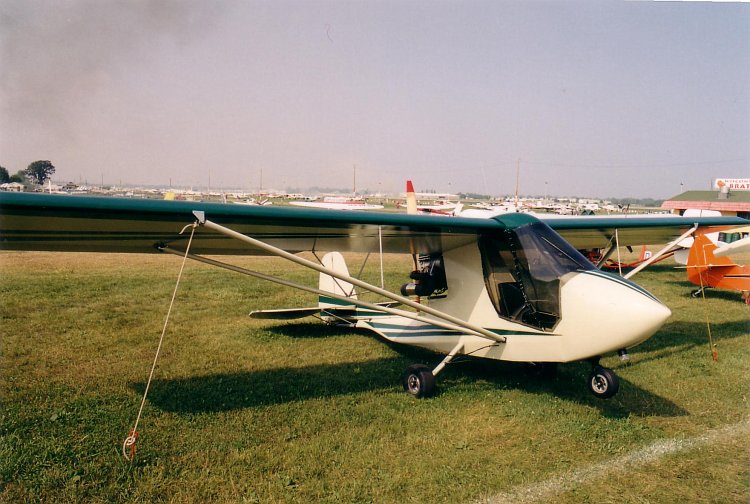Quad City Challenger II on:
[Wikipedia]
[Google]
[Amazon]




 The Quad City Challenger is a family of one and two seats-in- tandem,
The Quad City Challenger is a family of one and two seats-in- tandem,
/ref>Kitplanes Staff: ''2008 Kit Aircraft Directory'', page 67, Kitplanes Magazine December 2007 Volume 24, Number 12, Belvior Publications, Aviation Publishing Group LLC.

pusher configuration
In an aircraft with a pusher configuration (as opposed to a tractor configuration), the propeller(s) are mounted behind their respective engine(s). Since a pusher propeller is mounted behind the engine, the drive shaft is in compression in nor ...
, tricycle landing gear
Tricycle gear is a type of aircraft undercarriage, or ''landing gear'', arranged in a tricycle fashion. The tricycle arrangement has a single nose wheel in the front, and two or more main wheels slightly aft of the center of gravity. Tricycle g ...
ultralight aircraft
Ultralight aviation (called microlight aviation in some countries) is the flying of lightweight, 1- or 2-seat fixed-wing aircraft. Some countries differentiate between weight-shift control and conventional three-axis control aircraft with ailer ...
that is designed and produced by Quad City Aircraft Corporation of Moline, Illinois
Moline ( ) is a city located in Rock Island County, Illinois, United States. With a population of 42,985 in 2020, it is the largest city in Rock Island County. Moline is one of the Quad Cities, along with neighboring East Moline, Illinois, East M ...
. The Challenger was first introduced in 1983.Vandermeullen, Richard: ''2011 Kit Aircraft Buyer's Guide'', Kitplanes, Volume 28, Number 12, December 2011, page 66 Belvoir Publications. ISSN 0891-1851Challenger Advanced Ultralight & Light Sport Aircraft - National Ultralight Canada & Quad City U.S/ref>Kitplanes Staff: ''2008 Kit Aircraft Directory'', page 67, Kitplanes Magazine December 2007 Volume 24, Number 12, Belvior Publications, Aviation Publishing Group LLC.
Design and development
The Challenger ultralight is a high wing, tricycle gear kit aircraft with a frame structure built from 6061-T6 aluminum alloy tubing fastened with aircraft grade AN bolts andrivet
A rivet is a permanent mechanical fastener. Before being installed, a rivet consists of a smooth cylindrical shaft with a head on one end. The end opposite to the head is called the ''tail''. On installation, the rivet is placed in a punched ...
s and covered with either presewn Dacron
Polyethylene terephthalate (or poly(ethylene terephthalate), PET, PETE, or the obsolete PETP or PET-P), is the most common thermoplastic polymer resin of the polyester family and is used in fibres for clothing, containers for liquids and foods ...
envelopes or standard aircraft fabric. The engine is mounted in pusher configuration
In an aircraft with a pusher configuration (as opposed to a tractor configuration), the propeller(s) are mounted behind their respective engine(s). Since a pusher propeller is mounted behind the engine, the drive shaft is in compression in nor ...
and turns the propeller
A propeller (colloquially often called a screw if on a ship or an airscrew if on an aircraft) is a device with a rotating hub and radiating blades that are set at a pitch to form a helical spiral which, when rotated, exerts linear thrust upon ...
through a reduction drive that uses a cogged tooth rubber belt.Cliche, Andre: ''Ultralight Aircraft Shopper's Guide'' 8th Edition, pages B-11 & B-71. Cybair Limited Publishing, 2001.
The kit can be purchased in 4 major sub-kits: the Tail Assembly, Fuselage, Wings, and Engine. The factory kit is supplied with the most difficult mechanical work already completed. This includes the primary fuselage
The fuselage (; from the French ''fuselé'' "spindle-shaped") is an aircraft's main body section. It holds crew, passengers, or cargo. In single-engine aircraft, it will usually contain an engine as well, although in some amphibious aircraft t ...
framework along with the controls and the basic wing structures assembled at the factory. The kit builder is required to finish the smaller structural components, cover the aluminum frames with fabric, seal and paint the fabric and do the final assembly.
The aircraft has the ability to soar with its motor switched off.
The Challenger design has been criticized by reviewers for its landing gear, which is a rigid cable-braced type and is subject to being bent during hard landings. A number of after-market suppliers have designed steel gear legs as replacements for the stock landing gear in an attempt to rectify this problem. The improved factory-designed Light Sport Special (LSS) model incorporates revised landing gear to address this deficiency.Cliche, Andre: ''Ultralight Aircraft Shopper's Guide'' 8th Edition, pages B-75. Cybair Limited Publishing, 2001. Bayerl, Robby; Martin Berkemeier; et al: ''World Directory of Leisure Aviation 2011-12'', page 116. WDLA UK, Lancaster UK, 2011. ISSN 1368-485X
In November 2018, the design was subject to a Transportation Safety Board of Canada Aviation Safety Advisory due to an accident on 30 July 2018 where a Challenger crashed and the pilot was killed. The investigation determined that the right front lift strut lower bracket had failed due to fatigue after only 402.2 hours in service. The bracket has a 500 hour component life and is subject to 50 hour periodic inspections. Examination of 22 other Challengers found eight that also had cracked brackets.
Variants
;Challenger I (Challenger UL) :Single seat, wingspan gives lower stall speed. Can be fitted with a variety of engines. Qualifies as a US "Experimental - Amateur-Built", Light sport aircraft or with theHirth F-33
The Hirth F-33 is a single cylinder, two stroke, carburetted aircraft engine designed for use on ultralight aircraft, including powered paragliders and ultralight trikes. the engine is noted for its extremely light base weight of . It is ma ...
engine as a US FAR 103 ''Ultralight Vehicle'', 800 reported completed and flown by the fall of 2011.
;Challenger I Special
:Single seat, wingspan gives faster roll rate. Engines Rotax 447, Rotax 503, 582
__NOTOC__
Year 582 ( DLXXXII) was a common year starting on Thursday (link will display the full calendar) of the Julian calendar. The denomination 582 for this year has been used since the early medieval period, when the Anno Domini calendar e ...
or HKS 700E
The HKS 700E is a twin-cylinder, horizontally opposed, four stroke, carburetted aircraft engine, designed for use on ultralight aircraft, powered parachutes and ultralight trikes. The engine is manufactured by HKS, a Japanese company noted for ...
. Qualifies as a US Experimental - Amateur-Built or Light sport aircraft, 300 reported completed and flown by the fall of 2011.
;Challenger II
:Two seats in tandem, wingspan provides more lift and lower stall speed. Can be equipped with floats. Engines Rotax 447, Rotax 503, 582
__NOTOC__
Year 582 ( DLXXXII) was a common year starting on Thursday (link will display the full calendar) of the Julian calendar. The denomination 582 for this year has been used since the early medieval period, when the Anno Domini calendar e ...
or HKS 700E
The HKS 700E is a twin-cylinder, horizontally opposed, four stroke, carburetted aircraft engine, designed for use on ultralight aircraft, powered parachutes and ultralight trikes. The engine is manufactured by HKS, a Japanese company noted for ...
. Qualifies as a US Experimental - Amateur-Built or Light sport aircraft, 2000 reported completed and flown by the fall of 2011.
;Challenger II Special
:Two seats in tandem, wingspan gives faster roll rate. Engines Rotax 447, Rotax 503, 582
__NOTOC__
Year 582 ( DLXXXII) was a common year starting on Thursday (link will display the full calendar) of the Julian calendar. The denomination 582 for this year has been used since the early medieval period, when the Anno Domini calendar e ...
or HKS 700E
The HKS 700E is a twin-cylinder, horizontally opposed, four stroke, carburetted aircraft engine, designed for use on ultralight aircraft, powered parachutes and ultralight trikes. The engine is manufactured by HKS, a Japanese company noted for ...
. Qualifies as a US Experimental - Amateur-Built or Light sport aircraft, 350 reported completed and flown by the fall of 2011.
;Challenger II CW LSS
:Two seats in tandem, . Engine Rotax 503, 582
__NOTOC__
Year 582 ( DLXXXII) was a common year starting on Thursday (link will display the full calendar) of the Julian calendar. The denomination 582 for this year has been used since the early medieval period, when the Anno Domini calendar e ...
or HKS 700E
The HKS 700E is a twin-cylinder, horizontally opposed, four stroke, carburetted aircraft engine, designed for use on ultralight aircraft, powered parachutes and ultralight trikes. The engine is manufactured by HKS, a Japanese company noted for ...
. This model incorporates many revisions to the basic Challenger design, including a larger and re-shaped vertical fin, fiberglass
Fiberglass (American English) or fibreglass (Commonwealth English) is a common type of fiber-reinforced plastic using glass fiber. The fibers may be randomly arranged, flattened into a sheet called a chopped strand mat, or woven into glass cloth ...
wing tips and redesigned landing gear
Landing gear is the undercarriage of an aircraft or spacecraft that is used for takeoff or landing. For aircraft it is generally needed for both. It was also formerly called ''alighting gear'' by some manufacturers, such as the Glenn L. Martin ...
. Qualifies as a US Light sport aircraft, 110 reported completed and flown by the fall of 2011.Tacke, Willi; Marino Boric; et al: ''World Directory of Light Aviation 2015-16'', page 121. Flying Pages Europe SARL, 2015.
;Challenger II LSS XL-65
:Two seats in tandem, . Engine Rotax 582. Qualifies as a US Light sport aircraft, ten reported completed and flown by the fall of 2011.
Specifications (Challenger II)
See also
References
External links
*{{Official website, http://www.qcaircraft.com/ 1980s United States ultralight aircraft Light-sport aircraft Single-engined pusher aircraft High-wing aircraft Aircraft first flown in 1983